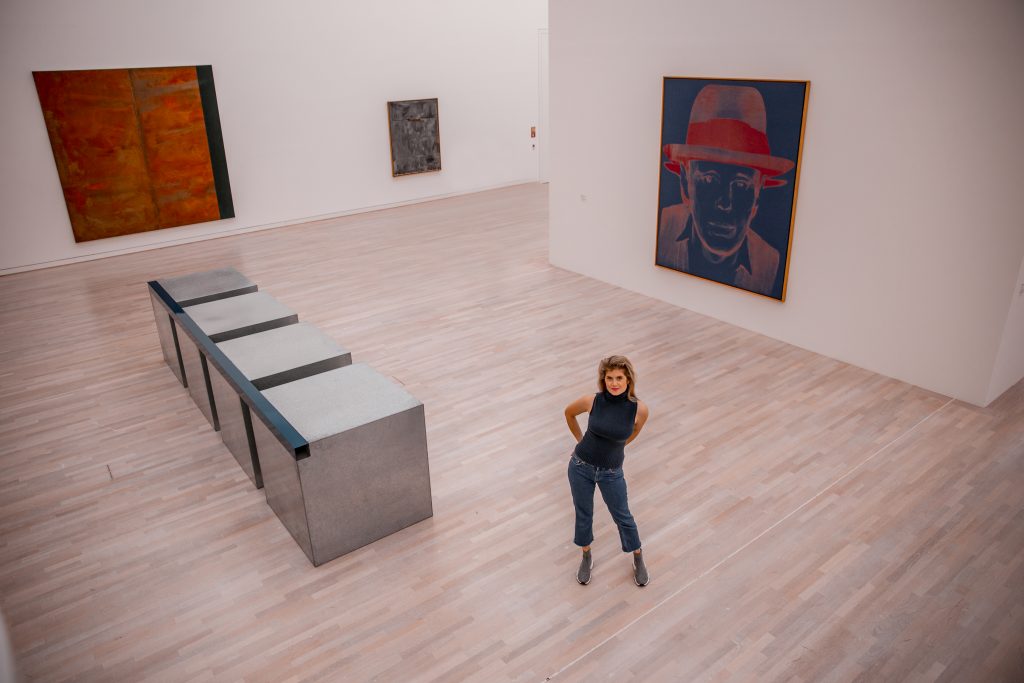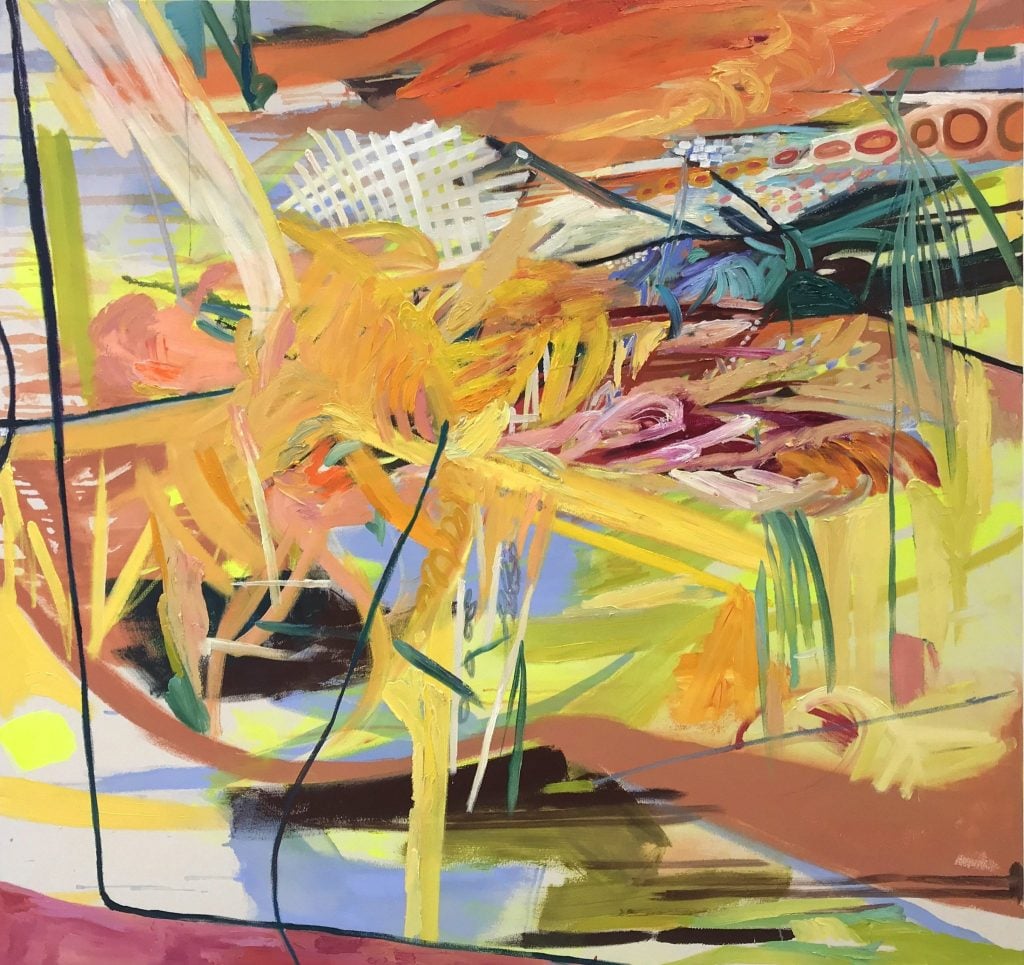Katharina Wenzel, Founder of Online Art Platform ARTPIQ, On Her Collaborative Vision For Supporting Emerging Artists
She shares her ideas on leveling the playfield for young artists with data-driven strategy—and the motto that keeps her motivated.

She shares her ideas on leveling the playfield for young artists with data-driven strategy—and the motto that keeps her motivated.

How do you support the career of emerging artists as well as challenge the status quo of the market? Entrepreneur and young mother of two, Katharina Wenzel, founder of online platform ARTPIQ, reveals her vision for the art market, the importance of driving online connections, and how she selects which artists to invest in.
You founded ARTPIQ in order to provide emerging artists with a platform to reach potential collectors as well as institutions. How do you select the artists you admit to your platform?
We follow a similar approach to early-stage investors that invest in great teams and people instead of great ideas. At the core of our selection process is the person behind the artist: we want to understand what drives them, their commitment, work ethic, etc. In short: Are they 100% committed and ready to become a full-time artist.
As many artists have experienced, becoming a financially stable full-time artist is a very difficult journey that takes a lot of courage, stamina, determination, and sacrifices along the way. As an art graduate, your choice is either to take the leap into self-employment and try your luck as a full-time artist or to find a regular job and continue your career on the side. This loss of focus is often the end of any successful career in the arts.
A look into the past proves how the odds of succeeding as an artist significantly increase if you have the freedom to focus 100% on your art. For example, Vincent Van Gogh who was financially supported by his brother throughout his life, Manet who had the backing of a wealthy family background and great support through an influential private network or Basquiat who was financially supported by his girlfriend and only started breaking through upon entering Peggy Guggenheim’s network.
We aim to be that trusted friend that accompanies the artists on their journey and help to remove any distractions. We focus mostly on artists from renowned art schools because research shows that the overwhelming majority of artists that are successfully traded on the secondary market attended an art school. Lastly, we obviously also consider their craft and technique and how that synergizes with my vision for ARTPIQ.
If you are an artist and if I could spark your interest, please get in touch with me via our website or Instagram. I’m always excited to meet new artists and hear their stories. This is definitely one of the perks of the job!

Theresa Kallrath, I Am a Moment (2020). Courtesy of ARTPIQ.
How does ARTPIQ help artists on their journey?
Once onboarded, success becomes very much a team effort as ARTPIQ is all about supporting the artists and being a true partner. Our approach is very simple: We are trying to help the artist build a collector base while they’re still at university, so that by the time they graduate they already have an income stream that helps them transition into self-employment while still focussing 100% on what they do best—creating great art!
We focus not only on traditional collectors but are actively trying to reach a new audience of young first-time collectors. I believe that anyone can fall in love with art, thus, collectors can come from all sorts of different walks of life.
As part of our support, we organize artist residencies and partnerships aimed at supporting the artists financially as well as increase exposure. Our latest project was with FLAG in Frankfurt where we showed art in a new design hotel, giving our artists a great platform to reach new potential collectors. I’m also excited about the new collaboration with Pinetrees and “the Bilkery” where we utilize vacant commercial real estate for pop-up exhibitions with our artists.
Based on our online channels we know that first time buyers prefer large-scale paintings over installations and sculptures, but at a price point that’s not too high. However, as large scale paintings are naturally at the upper price range of any artist’s portfolio this presents a unique challenge. To overcome this dilemma without discounting the value of our artists’ works, we have come up with alternative approaches in order to create interesting opportunities for first-time buyers. For example, we have worked on limited & hand-signed fine art print editions, exclusive and limited merchandise editions for selected partners such as customized Replay jeans painted by Theresa Kallrath.
We’ve also introduced alternative payment options, such as installment purchases, as well as leasing and rental options for businesses. This way, customers have the opportunity to experience multiple artworks while we don’t have to compromise the value of the artwork. But no matter what we do, we never interfere with the artist’s creative process, and everything we do is the result of a collaborative partnership with our artists.

Sin Park, Two Landscapes. Courtesy of ARTPIQ.
It is notoriously difficult to build a new venture. What experience within the art market convinced you to persevere?
The art market is a very traditional and old fashioned market place with a lot of ‘don’ts’ and ‘no-goes’ which I find to be outdated and antiquated. One example is the discussion about ‘good’ art: to date, the opinion of few tastemakers that are accepted by the art market has more influence than popular demand. This dynamic heavily discriminates against young artists and buyers alike.
Trying to innovate a market or starting a new venture is never easy. But very much like our artists, I am fully dedicated to working on making art accessible to a broader audience independent of social class, income, or any other stereotype often still attached to the traditional art world. Coming out of a very entrepreneurial family, I have had the privilege to learn that regardless of all the challenges, there is nothing more rewarding than to be able to follow your passion.
Building this business is absolutely a challenge, especially as a young mother with two little boys. For me, it’s not simply about showing the art world that some things need to change, but also about showing society that being a good mom does not have to come at the expense of your professional passion.
Artists value being shown in a physical space. How do you translate the online experience into an offline show?
I believe that offline events need to deliver new, potential collectors with a truly unique experience. Thus, we try to integrate art into everyday settings so new audiences can enjoy it in a relaxed and comfortable environment where they feel at home.
But I’m also a firm believer that an online space is far more effective at guiding the customer through the early stages of the decision-making process. On our website, you can browse through a great selection of different artists at your own pace, while simultaneously having the opportunity to reach out to us in order to arrange offline experiences such as studio visits and personal consultations.
Social media has become more and more important for engaging young collectors and reaching a wider audience. Does this engagement translate into sales?
Yes, it definitely does! At the beginning I was unsure whether it might ‘devalue’ an artwork by posting it on Instagram with a price tag, however, this kind of transparency is key for having a good customer experience.
Ultimately it’s a relatively simple rationale: People can only buy what they know and social media is like a massive shop-window. So, rather than having a physical store that enjoys regular foot traffic from a relatively constant, local audience, our social media accounts enable us to reach new audiences every day. In my opinion, it’s as simple as that.
However, often people feel more comfortable with a personal connection at some point. Here, social media is perfect as it enables a super smooth transition between the anonymity of online to the personal touch of offline.
You strategically place works in venues that can be seen as a cross-section between art and commerce, including hotels and boutiques. Do you believe that this type of exposure is the future of the arts?
My aim is to give everyone the chance to get to know art in the most natural way possible. So, placing artworks in venues that naturally host a large audience of people seemed perfect to me.
I can’t tell whether this is the future of the art market but I believe that art was always about portraying society and was meant to mirror current trends and movements. In the end, one key objective of many collections and museums is to make art accessible to everyone.
How has the COVID-19 crisis affected your business?
In some aspects, the effects are still unknown. While it was and is a global challenge, it also presented some opportunities for positive change in several industries. In the art world, many spent more time online and on social media, so we, like other businesses, actually saw higher engagement here. On the flip side, due to a lack of child care options and my husband needing to travel to New Zealand for almost two months, it was very challenging for me to balance ARTPIQ and motherhood during the lockdown.
What advice would you give young women keen on making a career within the art market?
Be yourself, be bold, and don’t be afraid to question the status quo. There’s a German proverb that says it all: “Everyone said that was not possible, then someone came who didn’t know and just did it.”

If you could have dinner with any three artists, living or dead. Who would you choose?
Wow! That’s a very difficult question. Nowadays I luckily actually have the opportunity to grab a coffee with many different artists, but if I had to pick three…
Alberto Giacometti as I studied his works intensively and with great pleasure during my high school and uni days. He inspired me in many ways to pursue a career in the arts.
Alex Israel because I love how accessible his art is for young people, how he charters new territories which his collaborations, which also often are at the verge of art and everyday life and last but not least I simply enjoy his creativity and positive vibe of his projects
And Carmen Herrera, because I would love to understand the secret to her incredible stamina and drive and how she managed to pull through being an artist for all those years until she was finally ‘discovered’ by Lisson Gallery as well as if this gallery support changed anything for herself and her view on art.
So shout out to both Carmen and Alex as you are still very much alive, I would love to grab dinner or just a coffee with you. In case you ever have an opening in your agenda, even if it’s super last minute, let me know because I would love to meet you.